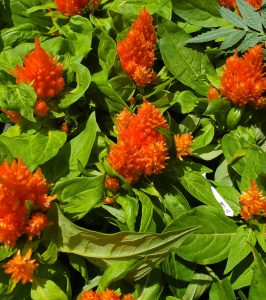
An annual flowering bedding plant that you might try this summer is the Celosia. Coming in three forms – plume, cockscomb, and wheat – this highly colorful and heat tolerant annual flower is a must. The velvety texture and neon-bright colors are a visual delight in any planting bed or container.
Celosias are part of the amaranth family which include many ornamental relatives. These annuals can be purchased locally as ready-to-plant transplants or started from seed. Some may take up to ninety days to reach the flowering stage, but this is no problem as we have a long, hot summer. Start these summer annuals in peat pots – several seeds to a pot. Once the plants have several true leaves pinch out all but the best specimen leaving only one per pot – don’t save any extras as they do not transplant well. Depending on the ultimate size and purpose of the Celosia, plant seedlings from ten to twelve inches apart for small cultivars, a up to sixteen inches apart of larger types. Celosia can also be direct seeded into a full sun garden featuring well-drained soil – follow label planting directions for more details. As they grow, ruthlessly thin our extra seedings until they are properly spaced for best growth. Direct-seeded celosia reportedly have larger flowering heads. For small spaces, consider celosia in pots for movable color and texture.
Probably the most commonly grown celosia is the plume-like form. Coming in colors of yellow, red, and orange, the unnaturally bright flame-like blooms top the eight-to-twenty-four-inch green leafy plant. This long-lasting flowerhead is made up of individual spikes of feathery flowers arranged in a pyramidal, tree-like pattern. The so-called cockscomb or crested celosia is very different in appearance and looks like an odd-shaped velvety brain – almost coral-like in appearance. The fan-like, fascinated flowers do look like a rooster’s comb. They can become so heavy that staking is required. The third form of celosia is called wheat – increasingly popularity in many gardens. Wheat types send out a flowering spike that reminds you of colorful pink or pinkish-red heads of wheat – one called ‘Flamingo Feather’ is commonly available . This type also has edible leaves when young.
The dwarf types of all forms of celosia make excellent bedding plants especially when installed in a mass planting almost like a groundcover. Taller types make good cut flowers as well as dried flowers for fall arrangements – red varieties do the best for drying as they hold their color. Some of the tall varieties may require staking, so keep this in mind as they mature. Celosia is an approved Florida-Friendly Landscaping™ plant suitable to our area and summer climate, and – at least the wheat form celosia – is not a problem species according to the UF/IFAS Assessment of Non-Native Plants in Florida’s Natural Areas.
Finding summer-tolerant bedding annuals is sometimes difficult but be assured that celosias will thrive and provide some quirky color this upcoming season. For more information on all types of flowering annuals, or to ask a question, you can also call the Master Gardener Volunteer Helpdesk on Mondays, Wednesdays, and Fridays from 1 to 4 pm at 764-4340 for gardening help and insight into their role as an Extension volunteer. Ralph E. Mitchell is the Director/Horticulture Agent for UF/IFAS Extension – Charlotte County. Ralph E. Mitchell is the Director/Horticulture Agent for UF/IFAS Extension Charlotte County. He can be reached at 941-764-4344 or ralph.mitchell@charlottecountyfl.gov. Connect with us on social media. Like us on Facebook @CharlotteCountyExtension and follow us on Instagram @ifascharco.
Resources:
Gilman, E. F. & Howe, T. (2023) CELOSIA PLUMOSA COCKSCOMB. The University of Florida Extension Service, IFAS
Dalman, N. (2012) Celosia. The University of Minnesota – West Central Research and Outreach Center.
Barash, C. W. (2006) Celosia (Celosia cristata). (National Garden Bureau) Horticulture Update – Texas Cooperative Extension, Texas A&M University.
Mahr, S. (2018) Wheat Celosia, Celosia spicata. University of Wisconsin – Madison.
The Florida-Friendly Landscaping™ Guide to Plant Selection & Landscape Design (2022) The University of Florida Extension Services.
UF/IFAS Assessment of Non-Native Plants in Florida’s Natural Areas. (2024). The University of Florida Extension Service, IFAS.
Celosia – https://en.wikipedia.org/wiki/Celosia.
 0
0
